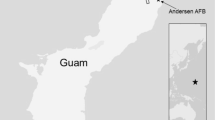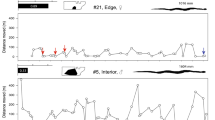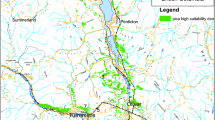Abstract
Mass aerial delivery of dead mouse baits treated with acetaminophen has been evaluated as a means to reduce brown tree snake (Boiga irregularis) populations over large areas, increasing the likelihood of wide-scale eradication on Guam. Given the high density of snakes in some areas of their invasive range, eradication efforts could result in a resource pulse that may influence food web dynamics and the indirect transport of acetaminophen among trophic levels. We evaluated abundance, habitat type, and snake size (i.e., age) within two study sites on Guam, a secondary limestone forest (upland) and an abandoned coconut plantation (coastal), to determine how experimentally dosing snakes with acetaminophen is likely to influence carrion availability. We found snakes trapped in 3.24 ha plots occurred in greater abundance (population size = 72.5 snakes; SE = 8.8) and were significantly larger (978.6 mm, SE = 14.9) in the coastal than in the upland site (population size = 26.9, SE = 21.5; length = 903.0 mm, SE = 15.9). Despite these differences, carcasses of snakes that died after consuming acetaminophen-laced mice (80 mg) were recovered in consistent locations between sites, with 92 % located on the ground, 4 % in trees, and 4 % found in rock cavities at both sites. Given that most snakes were found on the ground rather than in the tree canopy, our results suggest that many poisoned snake carcasses will be accessible to a wide range of potential scavengers, possibly influencing food web dynamics and potentially contributing to indirect toxicant transfer within affected ecosystems.
Similar content being viewed by others
References
Beasley JC, Olson ZH, DeVault TL (2012) Carrion cycling in food webs: comparisons among terrestrial and marine ecosystems. Oikos 121:1021–1026
Brown WS, Parker WS (1976) A ventral scale clipping system for permanently marking snakes (Reptilia, Serpentes). J Herpetol 10:247–249
Brown Treesnake Working Group (2004) Allocation and spending overview. U.S. Fish and Wildlife Service, Houston, Texas, USA
Bump JK, Webster CR, Vucetich JA, Peterson RO, Shields JM, Powers MD (2009) Ungulate carcasses perforate ecological filters and create biogeochemical hotspots in forest herbaceous layers allowing trees a competitive advantage. Ecosystems 12:966–1007
Burnham KP, Anderson DR (2002) Model Selection and multimodel inference: a practical information-theoretic approach, 2nd edn. Springer-Verlag, New York
Clark L, Savarie PJ (2012) Efficacy of aerial broadcast baiting in reducing brown treesnake numbers. Human-Wildlife Interactions 6:212–221
Clark L, Savarie PJ, Shivik JA, Breck SW, Dorr BS (2012) Efficacy, effort, and cost comparisons of trapping and acetaminophen-baiting for control of brown treesnakes on Guam. Human-Wildlife Interactions 6:222–236
DeVault TL, Brisbin IL, Rhodes OE (2004) Factors influencing the acquisition of rodent carrion by vertebrate scavengers and decomposers. Can J Zool 82:502–509
DeVault TL, Krochmal AR (2002) Scavenging by snakes: an examination of the literature. Herpetoloica 58:429–436
DeVault TL, Rhodes OE, Shivik JA (2003) Scavenging by vertebrates: behavioral, ecological, and evolutionary perspectives on an important energy transfer pathway in terrestrial ecosystems. Oikos 102:225–234
Environmental-engineering Management, Inc. (2008) Draft base-wide vegetation survey, mapping, and report at Andersen AFB, Guam. August 2008
Fritts TH (1998) The brown treesnake, Boiga irregularis, a threat to Pacific islands. U.S. Fish and Wildlife Service, Washington, D.C, Biological Report 88(31)
Fritts TH, McCoid MJ (1991) Predation by the brown tree snake (Boiga irregularis) on poultry and other domesticated animals on Guam. The Snake 23:75–80
Fritts TH (2002) Economic costs of electrical system instability and power outages caused by snakes on the Island of Guam. Int Biodeterior Biodegradation 49:93–100
Fritts TH, McCoid MJ, Gomez DM (1999) Dispersal of snakes to extralimital islands: incidents of the brown treesnake (Boiga irregularis) dispersing to islands in ships and aircraft. In: Rodda GH, Sawai Y, Tanaka H (eds) Problem snake management: The Habu and the brown treesnake, Cornell University Press, New York, pp 209–223
Fritts TH, Scott NJ, Savidge JA (1987) Activity of the arboreal brown tree snake (Boiga irregularis) on Guam determined by electrical outages. The Snake 19:51–58
Hocking MD, Reynolds JD (2011) Impacts of salmon on riparian plant diversity. Science 331:1609–1612
Howald GR, Mineau P, Elliott JE, Cheng KM (1999) Brodifacoum poisoning of avian scavengers during rat control on a seabird colony. Ecotoxicology 8:431–447
Johnston JJ, Savarie PJ, Primus TM, Eisemann JD, Hurley JC, Kohler DJ (2002) Risk assessment of an acetaminophen baiting program for chemical control of brown tree snakes on Guam - Evaluation of baits, snake residues, and potential primary and secondary hazards. Environ Sci Technol 36:3827–3833
Jordan MA, Rodda GH (1994) Identification of sex in Boiga irregularis: Implications for understanding population dynamics in Guam. J Herpetol 28:381–384
Lardner B, Savidge JA, Reed RN, Rodda GH (2014) Movements and activity of juvenile brown treesnakes (Boiga irregularis). Copeia 14:428–436
Mauldin RE, Savarie PJ (2010) Acetaminophen as an oral toxicant for Nile monitor lizards (Varanus niloticus) and Burmese pythons (Python molurus bivittatus). Wildlife Research 37:215–222
Otis DL, Burnham KP, White GC, Anderson DR (1978) Statistical inference from capture data on closed animal populations. Wildlife Monogr 1–135
Parmenter RR, MacMahon JA (2009) Carrion decomposition and nutrient cycling in a semiarid shrub-steppe ecosystem. Ecol Monogr 79:637–661
Pereira LM, Owen-Smith N, Moleon M (2014) Facultative predation and scavenging by mammalian carnivores: seasonal, regional and intra-guild comparisons. Mamm Rev 44:44–55
Pott M, Wegmann AS, Griffiths R et al. (2015) Improving the odds: assessing bait availability before rodent eradications to aid in selecting bait application rates. Biol Conserv 185:27–35
R Development Core Team (2014) R: a language and environment for statistical computing. R Foundation for Statistical Computing. http://www.R-project.org. Accessed 25 Oct 2015
Rodda GH, Fritts TH (1992) The impact of the introduction of the colubrid snake Boiga irregularis on Guam’s lizards. J Herpetol 26:166–174
Rodda GH, Fritts TH, Conry PJ (1992) Origin and population growth of the brown tree snake, Boiga irregularis, on Guam. Pac Sci 46:46–57
Rodda GH, Fritts TH, McCoid MJ (1999) An overview of the biology of the Brown Treesnake* (Boiga irregularis), a costly introduced pest on Pacific Islands. In: Rodda GH, Sawai Y, Tanaka H (eds) Problem Snake Management: the Habu and the brown treesnake, Cornell University Press, New York, pp 44–80
Rodda GH, Fritts TH, Perry G, Cambell EW (1998) Managing island biotas: can indigenous species be protected from introduced predators such as the brown treesnake? Transactions of the North American Wildlife and Natural Resources Conference 63:95–108
Rodda GH, Savidge JA (2007) Biology and impacts of pacific island invasive species. 2. Boiga irregulatis, the Brown Tree Snake (Reptilia: Colubiridae). Pac Sci 61:307–324
Rodda GH, Savidge JA, Tyrrell CL, Christy MT, Ellingson AR (2007) Size bias in visual searches and trapping of brown treesnakes on Guam. J Wildl Manage 71:656–661
Savarie PJ, Mathies TC, Fagerstone KA (2007) Flotation materials for aerial delivery of acetaminophen toxic baits to brown treesnakes. In: Witmer GW, Pitt WC, Fragerstone KA (eds) Managing Vertebrate Invasice Species: Proceedings of an International Symposium, USDA APHIS Wildlife Services, National Wildlife Research Center, Fort Collins, pp 218–223
Savarie, PJ, Shivik JA, Clark L, Linder TJ, York DL (2001a). Laboratory and field efficacy tests of acetaminophen in brown treesnakes (Boiga irregularis). In: Brown Treesnake 2001 Research & Management, Guam, p 21 [Abstract]
Savarie PJ, Shivik JA, White GC, Hurley JC, Clark L (2001b) Use of acetaminophen for large-scale control of brown treesnakes. J Wildl Manage 65:356–365
Savidge JA (1987) Extinction of an island forest avifauna by an introduced snake. Ecology 68:660–668
Savidge JA (2001) Population characteristics of the introdudced brown tree snake (Bioga irregularis) on Guam. Biotropica 23:294–300
Shalaby OA, deCarvalho LML, Goff ML (2000) Comparison of patterns of decomposition in a hanging carcass and a carcass in contact with soil in a xerophytic habitat on the Island of Oahu, Hawaii. J Forensic Sci 45:1267–1273
Shivik JA, Clark L (1997) Carrion seeking in brown tree snakes: importance of olfactory and visual cues. J Exp Zool 279:549–553
Shwiff SA, Gebhardt K, Kirkpatrick KN, Shwiff SS (2010) Potential economic damage from introduction of brown tree snakes, Boiga irregularis (Reptilia: Colubridae), to the Islands of Hawai’i’. Pac Sci 64:1–10
Snow RW, Krysko KL, Enge KM, Oberhofer L, WarrenBradley A, Wilkins L (2007) Introduced populations of Boa constrictor (Boidae) and Python molurus bivittatus (Pythonidae) in southern Florida. In: Henderson RW, Powell R (eds) Biology of the Boas and Pythons, Eagle Mountain Publishing, Eagle Mountain, Utah, pp 416–438
Tobin ME, Sugihara RT, Pochop PA, Linnell MA (1999) Nightly and seasonal movements of Boiga irregularis on Guam. J Herpetol 33:281–291
Towne EG (2000) Prairie vegetation and soil nutrient responses to ungulate carcasses. Oecologia 122:232–239
Vice DS, Engeman RM, Vice DL (2005) A comparison of three trap designs for capturing brown treesnakes on Guam. Wildl Res 32:355–359
Vice DS, Pitzler ME (2000) Brown treesnake control: economy of scales. In: Clark L (ed) Human conflicts with wildlife: economic considerations, Proceedings of the third NWRC special symposium, Fort Collins, pp 127–131
Weather Underground (2015) Weather history for PGUA. http://www.wunderground.com. Accessed 15 Aug 2015
White GC, Burnham KP (1999) Program MARK: survival estimation from populations of marked animals. Bird Study 46(Suppl):120–138
Wilson EE, Wolkovich EM (2011) Scavenging: how carnivores and carrion structure communities. Trends Ecol Evol 26:129–135
Wylie GD, Smith JJ, Amarello M, Casazza ML (2011) A taping method for external transmitter attachment on aquatic snakes. Herpetol Rev 42:187–191
Yang LH (2004) Periodical cicadas as resource pulses in North American forests. Science 306:1565–1567
Yang LH, Bastow JL, Spence KO, Wright AN (2008) What can we learn from resource pulses. Ecology 89(3):621–634
Acknowledgments
We thank M. Hall, S. Mosher, D. Lujan, and the staff at the United States Department of Agriculture Wildlife Service Andersen Air Force Base, Guam for logistical support and capture assistance. This work was supported through Cooperative Agreements between the University of Georgia Research Foundation and the United Stated Department of the Navy via the United States Department of Agriculture National Wildlife Research Center (No. 14-7439-1099-CA) and the United States Department of Energy (No. DE-FC09-07SR22506).
Author information
Authors and Affiliations
Corresponding author
Ethics declarations
Conflict of interest
The authors declare that they have no conflict of interest.
Disclaimer
This paper was prepared as an account of work sponsored by an agency of the United States Government. Neither the United States Government nor any agency thereof, nor any of their employees, makes any warranty, express or implied, or assumes any legal liability or responsibility for the accuracy, completeness, or usefulness of any information, apparatus, product, or process disclosed, or represents that its use would not infringe privately owned rights. Reference herein to any specific commercial product, process, or service by trade name, trademark, manufacturer, or otherwise does not necessarily constitute or imply its endorsement, recommendation, or favoring by the United States Government or any agency thereof. The views and opinions of authors expressed herein do not necessarily state or reflect those of the United States Government or any agency thereof.
Rights and permissions
About this article
Cite this article
Smith, J.B., Turner, K.L., Beasley, J.C. et al. Brown tree snake (Boiga irregularis) population density and carcass locations following exposure to acetaminophen. Ecotoxicology 25, 1556–1562 (2016). https://doi.org/10.1007/s10646-016-1711-1
Accepted:
Published:
Issue Date:
DOI: https://doi.org/10.1007/s10646-016-1711-1




